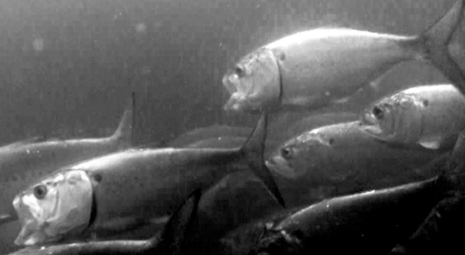Fish Oil, Really?
School:
Maryland Sea GrantLesson Summary
Omega-3 fatty acids, popularly known as “fish oil” are fats commonly found as a key component of the marine food chain. Marine sources (fatty fish like salmon, mackerel and sardines and other organisms such as krill) contain Omega-3's called eicosapentaenoic acid (EPA) and docosahexaenoic acid (DHA). “Where do these natural compounds come from?”
The answer, as well as the impact on the environment, may be surprising. For more information see the content primer.

Menhaden feeding on algae in Baltimore Inner Harbor. Photo by J. Adam Frederick
Research Experience:
This 5e Lesson Plan and Content Primer was developed with assistance from Baltimore County Public School teachers at Sudbrook Magnet Middle School, Allen R. Place (Institute of Marine and Environmental Technology) and Cathy Liu (Maryland Sea Grant Extension Program) to promote awareness and provide hands on experience related to the complexities associated with understanding omega 3 fatty acids and their relationship to the marine ecosystem, sustainable fisheries, and human health.5E For This Lesson Plan
Engagement
Engagement
This activity captures the students' attention, stimulates their thinking, and helps them to access prior knowledge.
Menhaden: A Keystone Species in the Bay
1. Students will watch the following video clips to make observations about menhaden feeding behavior and the menhaden fishery.
2. Introduce the Claim-Evidence-Reasoning method to students.
Exploration
Exploration
In this section students are given time to think, plan, investigate, collect and organize information.
The Nature of Plant and Animal Fats
Students will visually inspect and record observations of various fats from plant and animal sources.
Students will list the various physical properties of plant and animal fats at room temperature and compare/contrast plant and animal sources.
Students will perform a brown paper test to verify the presence of fats in each sample.
Students will inspect omega-3 oil from supplements and make a hypothesis about where “fish oil” best fits into fat classification (plant or animal).
Explanation
Explanation
Students are now involved in an analysis of their own explorations. Their understanding is clarified and modified because of the reflective nature of the activities.
Finding Answers in the Marine Ecosystem
Students will be introduced to a common producer in the marine environment by examining a live algae sample under the microscope.
Students will gain a better understanding of the importance of Menhaden in Chesapeake Bay and it's connection to consumer science.
Students will make connections between the value of the menhaden fishery and fish oil products produced by different manufacturing processes.
Extension
Extension
This section gives students an opportunity to expand and solidify their understanding of the concepts and to apply them in a real-world context.
An Analysis of Omega 3 Consumption
1. Students will extend their learning by filling out a survey of omega-3 products that places them into the role of a consumer and making sustainable choices regarding the marine ecosystem and fisheries.
Evaluation
Evaluation
This performance-based activity helps students to connect all of the pieces of information involved in these lessons.
An Informed Choice
1. Have students’ compare/contrast their knowledge of the marine food chain prior to the lesson and after the lesson. Related to the marine food chain have the students describe how they are connected or linked to this critical part of the marine environment and the how they benefit from the function of the food chain.
2. Options for Summative Evaluation
a. Have students write or develop a project about how our stewardship of ocean resources (fisheries) will be critical for a healthy marine ecosystem. Students should be able to support ideas about the benefits for themselves/society and in turn benefits to the marine environment.
b. Have students apply what they have learned about "Fish Oil" supplements and have them research and develop a narrative and project that describes dilemmas, pros and cons of other supplements that are misunderstood (e.g. Energy Drinks, Protein Supplements, Vitamins, etc.) Have then apply the same Fish Oil, Really? mentality to their research.





